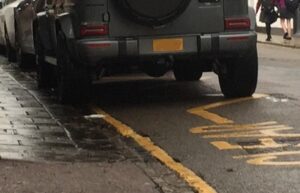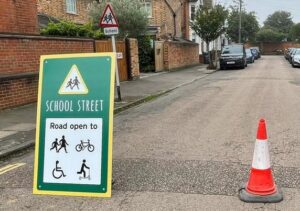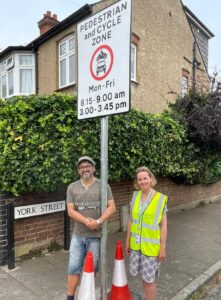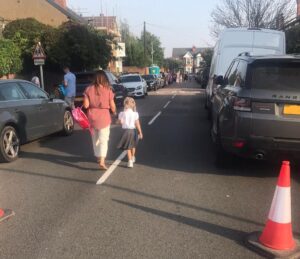Highlighting good practice
To mark Cycle to School week, we’re highlighting some good practice which encourages cycling to school all year round. Castle Newnham School is an all-age school on two sites in Bedford. A large majority of the children attending the site for primary-age pupils are very local, living in easy walking distance for non-disabled people. Nonetheless, the road near the school’s entrance had serious problems with poor parking by parents and carers at pick-up and drop-off time.
Congested streets near the school made cycling dangerous
The school entrance is very close to a 90-degree corner in the Victorian-era road. In addition, a lot of the houses don’t have drives or garages, and so residents park their cars on the road. With school pick-up and drop-off traffic, the result was parents getting agitated with each other, and causing problems for residents. There were regular requests for parking enforcement officers to attend.

The manoeuvring drivers also meant that it was difficult for children to safely cross the road.
Pavements became crowded and obstructed by opening doors (or occasionally car wheels, boots and bonnets overhanging the pavement).
Fumes from engines risked triggering asthma in children, and signs had been installed to encourage drivers to turn off their idling engines in a location with lots of young lungs of children whose noses and mouths were very close to the height of exhaust pipes.
Implementing a School Street for safer school journeys
The school, local council and councillors were all keen to promote Cycling, Walking and Wheeling to school, and the location, a loop of road with a good alternatives for traffic, meant that closures at pick-up and drop-off time would not block a through route.
Exceptions to the closures were also designed for residents, and families of pupils where parents or children are disabled.
However, the implementation of the “school street” didn’t go as smoothly as hoped as the entire active travel team at the council were made redundant!
This meant that the work of consulting with residents and parents fell to the school and local councillors. Timing of the consultation was further complicated by local elections meaning consultation dates had to be chosen outside of the pre-election period, so that the school was not seen as backing particular election candidates. When those complications were navigated, the positive consultation meant the scheme got a “green light”. The council had agreed in principal to put in place the Traffic Regulation Order needed for the new road rules and to cover costs, including the cost of the signposts at each end.

However, without an active travel team at the council it fell on the councillors, again, to organise a rota of volunteers to marshal the ends of the road during the school street closure each day. They were able to do so, leading to a successful launch of the school street.
Parents and children are noticing the positive difference the school street scheme makes
Cllr Bywater commented “It’s been great working with the school and council to get this off the ground and we’ve had a lot of positive comments from parents and children saying what a difference it makes to them.”

Fellow councillor Paul Edmonds added: “A School Street is just one part of safer streets, along with 20mph limits – already brought in across this area – which should help encourage more families to walk, wheel, and cycle to school. A great way to start and end the day and so much better for our environment.”
The school street came into operation for the start of the new school year, and is a one-year trial to start with. Cllr Bywater reports “I can already see a rise in the number of scooters and cycles used”.

Parent Karen said: “My son loves it as he can safely ride down the road. I feel far safer too.”
This is a great example of how walking, wheeling and cycling can be made viable while retaining vehicle access for Disabled people, residents and others who might need exemptions.
